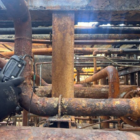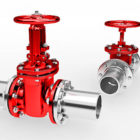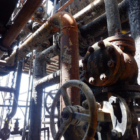The engineers and experts at TechCorr are committed to upholding the best practices in asset management and non-destructive testing (NDT). An illustration of this dedication was our recent examination of a horizontal recontracting drum following a fire incident.
The Challenge: This 60-inch-diameter vessel was constructed with SA-516-70 and SA-106 components; therefore, a thorough API 510 Compliance evaluation was required to identify any damage and ensure continued safe operation. The fire on the north and bottom of the drum caused level II damage, while other areas showed level I damage. The possibility of accelerated corrosion and metallurgical integrity remained concerns, despite initial investigations showing little mechanical deformation.
TechCorr’s expert team used cutting-edge nondestructive testing (NDT) methods, beginning with ultrasonic thickness testing (UT), to solve these problems. Our experts tested the thickness at 17 carefully chosen condition monitoring locations (CMLs) throughout the vessel, including the shell, heads, and nozzles, using a GE DMS Go device. After calibrating the UT values in Echo-to-Echo mode with the step wedge, it was confirmed that the corrosion rate was low, at 0.5 MPY, indicating minimal material loss. This information was essential for confirming the vessel’s post-fire structural integrity.
Our engineering team compared the grain structure and mechanical characteristics of samples from fire-affected and unaffected locations using metallography and hardness testing in addition to UT. The results of these tests confirmed that the metallurgical integrity of the vessel had not been harmed by the fire. Our maintenance recommendations were informed by a clear awareness of the vessel’s condition, thanks to our thorough approach.
The inspection revealed primarily coating damage, especially on the ladder, platform, and north side of the drum, with no mechanical deformations observed. Areas exposed to fire showed some minor corrosion, but it was still within acceptable bounds. Although there were pre-existing random cracks in the concrete, structural elements such as metallic saddles and concrete supports did not exhibit any damage from the fire.
The expert team at TechCorr made a number of maintenance recommendations in light of the findings, including recoating and sandblasting the platform and ladder, fixing the ladder’s concrete support, fireproofing the metallic saddles, maintaining and calibrating the Pressure Safety Valve (PSV), and running a hydrostatic test to make sure there are no leaks. These actions guarantee the vessel’s long-term integrity and operating preparedness.
This case study emphasizes how crucial sophisticated nondestructive testing procedures are to asset management. TechCorr’s team of engineers and specialists was able to reduce immediate risks and ensure the safety and efficiency of the vessel for future operations by carefully evaluating and resolving any difficulties. This proactive strategy highlights TechCorr’s industry leadership and illustrates our dedication to maintaining operational excellence and industrial safety.






